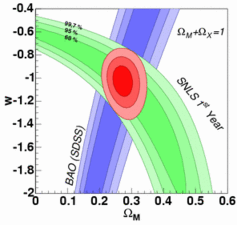|
Page 3 of 3 The work of the Observational Astrophysics Group was divided into two main areas: Cosmology with Supernovae (SNe), cosmic microwave background (CMB) and 21 cm experiments; Sun-Earth Interaction (SEI) and stellar evolution. The objectives were: 
Cosmology with SNE, CMB and 21 cm experiments:Second generation SNe surveys started in 2002, with the purpose of determining the nature of dark energy. Our group joined the Supernova Legacy Survey (SNLS), a 5-year international project to detect and study 200 SNe using the Canada-France-Hawaii telescope.Our objective was to participate in SNe detection, data reduction and software development. SNe studies in the context of the Supernova Cosmology Project were also to be continued. The determination of systematic errors contaminating SN studies was a main goal. Obscuring our view of the CMB and 21 cm experiments are extragalactic and galactic foregrounds. CENTRA planned to install in Portugal a radio telescope similar to the GEM-Galactic Emission Mapping, to map the polarized synchrotron radiation in the frequency range 2-15 GHz. This northern hemisphere survey would match southern hemisphere surveys to produce high quality sky maps. GEM is now considered as an ancillary experiment to Planck Surveyor.
 Finally, we planned to use next-generation radio-interferomenters to detect the redshifted 21 cm line from neutral hydrogen and study the epoch of reionization. SN, CMB and 21 cm experiments will help to constrain our current view of cosmology. SEI and stellar evolutionIn an ever more technologically dependent world, the field of space weather forecasting is increasingly important, although it is still far from the Earth-based standards. One of the main areas of interest in this field is the evolution of te Sun, which is also at the heart of our research. We pursue work in this field with solar seismology and astereoseismology, which have already shown their ability to probe the solar interior. New layer...
|